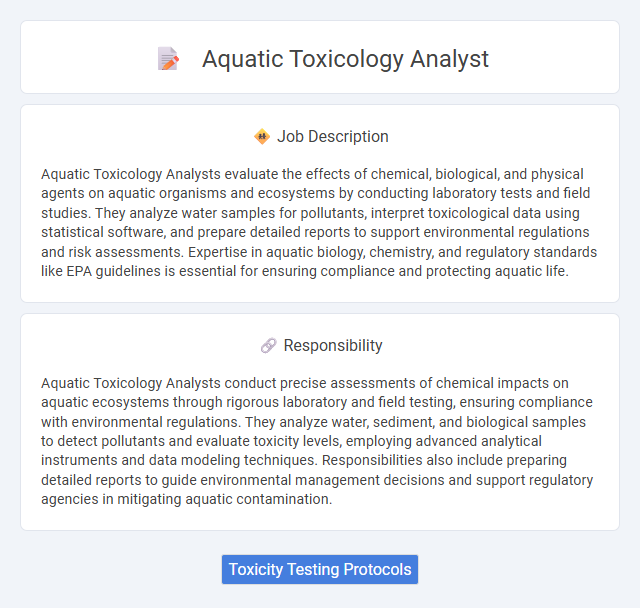
Aquatic Toxicology Analysts evaluate the effects of chemical, biological, and physical agents on aquatic organisms and ecosystems by conducting laboratory tests and field studies. They analyze water samples for pollutants, interpret toxicological data using statistical software, and prepare detailed reports to support environmental regulations and risk assessments. Expertise in aquatic biology, chemistry, and regulatory standards like EPA guidelines is essential for ensuring compliance and protecting aquatic life.
Individuals with a strong background in environmental science and biology are likely suitable for an Aquatic Toxicology Analyst role, as it demands thorough knowledge of aquatic ecosystems and pollutant effects. Those comfortable with detailed laboratory work, data analysis, and field research may find the job aligns well with their skills and interests. People who prefer dynamic environments and have a keen interest in protecting water quality might find this career particularly fulfilling and appropriate for their strengths.
Qualification
An Aquatic Toxicology Analyst requires a strong foundation in environmental science, biology, or chemistry, typically with a bachelor's or master's degree in these fields. Proficiency in laboratory techniques, data analysis, and familiarity with toxicological software are essential qualifications. Experience in aquatic ecosystems, regulatory standards, and conducting bioassays for contaminants ensures effective evaluation of toxic impacts on aquatic life.
Responsibility
Aquatic Toxicology Analysts conduct precise assessments of chemical impacts on aquatic ecosystems through rigorous laboratory and field testing, ensuring compliance with environmental regulations. They analyze water, sediment, and biological samples to detect pollutants and evaluate toxicity levels, employing advanced analytical instruments and data modeling techniques. Responsibilities also include preparing detailed reports to guide environmental management decisions and support regulatory agencies in mitigating aquatic contamination.
Benefit
An Aquatic Toxicology Analyst role may provide valuable opportunities for professional growth by working with cutting-edge environmental testing technologies. The position could offer competitive compensation packages alongside benefits such as health insurance and retirement plans to ensure employee well-being. Access to ongoing training and collaboration with interdisciplinary teams might enhance expertise in aquatic ecosystems and toxicological impact assessments.
Challenge
The challenge of an Aquatic Toxicology Analyst role likely involves accurately assessing the impact of various chemical substances on aquatic ecosystems while navigating complex environmental variables. Balancing the precision of toxicological data interpretation with regulatory requirements may pose ongoing difficulties. This position probably demands continuous adaptation to emerging contaminants and evolving scientific methodologies.
Career Advancement
Aquatic Toxicology Analysts specialize in assessing the impact of pollutants on aquatic ecosystems, utilizing advanced bioassays and chemical analyses to ensure environmental safety. Career advancement opportunities include leading research projects, managing environmental compliance programs, and contributing to regulatory policy development for water quality standards. Expertise in toxicological data interpretation and proficiency with analytical instruments significantly enhance prospects for senior roles and consultancy positions.
Key Terms
Toxicity Testing Protocols
Aquatic Toxicology Analysts specialize in designing and implementing toxicity testing protocols to assess the impact of chemicals and pollutants on aquatic organisms. These protocols often involve acute and chronic exposure studies, bioassays with species like fish, daphnia, and algae, and the measurement of endpoints such as mortality, growth inhibition, and reproductive effects. Expertise in standardized methods such as ASTM, EPA guidelines, and OECD test procedures ensures accurate evaluation of environmental hazards for regulatory compliance and ecological risk assessment.
 kuljobs.com
kuljobs.com